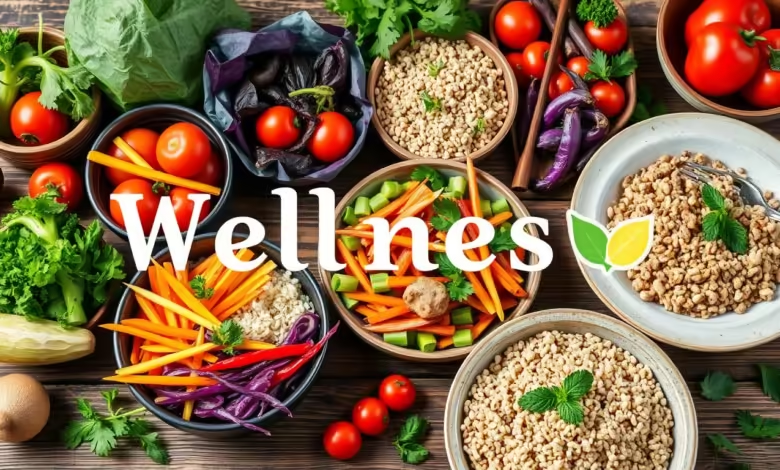Tasty Low Calorie High Volume Meals for Satisfaction

Losing weight or keeping a healthy lifestyle doesn’t mean giving up on taste and satisfaction. This article will show you how to make low-calorie, high-volume meals that fill you up without adding extra calories. We’ll talk about the benefits of volumetric eating, nutrient-dense superfoods, and calorie-dilute cuisine to help you meet your goals and enjoy the process.
A vibrant and colorful spread of low calorie high volume meals showcasing fresh vegetables, lean proteins, and whole grains arranged on a rustic wooden table. The dishes include a large salad with mixed greens, cherry tomatoes, cucumbers, and a light vinaigrette, a bowl of vegetable soup bursting with colors, and a portion of quinoa topped with roasted vegetables. Each meal emits an inviting and satisfying appearance, emphasizing healthy ingredients and generous portion sizes. The brand name “Wellness” is subtly integrated into the atmosphere of the scene without being overt.
If you want to lose weight or live healthier, these high-fiber foods and portion control recipes are key. You’ll learn how satiety-promoting foods work and the skills for healthy meal prep. This makes weight loss diet easier. Prepare to enjoy low-calorie density foods that make you feel full and healthy.
Unleashing the Power of Volumetric Eating
Feeling unsatisfied after meals and still craving more? Volumetric eating could change that. It’s a new way to eat that focuses on low calorie density foods. Both the fiber and water levels of these foods are high. This lets you enjoy nutrient- thick refections without feeling shamefaced.
Discover the Science of Satiety
Volumetric eating is all about understanding how to feel full. By eating satiety-promoting foods that are filling but low in calories, you can eat less and feel more satisfied. This helps with portion control and supports lasting weight loss.
Transform Your Approach to Meals
- Choose high-volume, low-calorie foods like fruits, vegetables, and lean proteins for satisfying meals.
- Try portion control recipes that are big in volume but low in calories. This way, you can enjoy your favorite dishes without guilt.
- Change your mindset from feeling deprived to feeling abundant. Focus on the delicious flavors and textures of volumetric eating.
With volumetric eating, you can change how you see food and feel more satisfied. This new approach can lead to better weight management and health.
Low Calorie High Volume Meals: A Game-Changer
Adding low-calorie, high-volume meals to your diet can change the game for weight loss and health. These meals are packed with nutrients but won’t add extra pounds. They help you control your calorie intake and help you meet your weight loss goals.
The key to low-calorie high-volume meals is calorie-dilute cuisine. These foods are low in calories but big in volume. So, you can eat further without feeling shamefaced. This method supports weight loss diet tips and helps you stay on track by keeping you full and satisfied.
Low-calorie high-volume meals also make healthy meal prep ideas better. By planning and preparing these meals ahead, they fit easily into your daily life. This makes sticking to your weight loss pretensions simpler.
If you want to lose weight or live healthier, low-calorie high-volume meals are a great choice. Check out calorie-dilute cuisine and see how these dishes can change your weight management and health for the better.
A colorful and vibrant spread of low calorie high volume meals, featuring a large bowl of mixed leafy greens topped with sliced colorful vegetables, a portion of quinoa, a serving of grilled chicken breast with herbs, and a side of steamed broccoli, beautifully arranged on a wooden table, with natural lighting highlighting the freshness of the ingredients –v 5 –ar 16:9 –chaos 20 –style 4k –q 2 –brand name “Wellness”.
Nutrient-Dense Superfoods for Delicious Bulk
Discover the power of nutrient-dense superfoods to make your meals more filling without adding too many calories. These foods are full of fiber and lean protein. They can alter your eating habits so that each mouthful satisfies and nourishes you.
Embrace Fiber-Rich Vegetables
Vegetables are key to a diet rich in nutrients and fiber. They include leafy greens, cruciferous veggies, and colorful fruits and vegetables. These high fiber foods are low in calories but full of vitamins, minerals, and antioxidants. Adding them to your meals can help you feel full, which is good for managing your weight.
A colorful assortment of nutrient-dense meals featuring vibrant vegetables, lean proteins, and whole grains displayed on a rustic wooden table, emphasizing bulk and satisfaction, with a focus on fresh herbs and superfoods, aesthetically arranged in bowls and plates. Branding element: “Wellness” subtly integrated into the scene through natural elements like a leaf or vegetable design.
Lean Protein: The Satiety Booster
Lean protein sources like chicken, turkey, fish, and legumes are great for feeling full. They make you feel satisfied and help control hunger hormones. This keeps you full and gives you energy for a long time. Adding these lean protein foods to your meals makes them more satisfying and supports your health goals.
By choosing fiber-rich vegetables and lean protein, you can make your meals more nutritious. This will change how you see food. You’ll enjoy eating more, feeling full, and supporting your health goals.
Mastering Portion Control with High-Volume Meals
Controlling your food portions can be tough for a healthy diet. But, volumetric eating and low-calorie density foods can help. You can enjoy big meals without feeling too full or eating too much.
Visual Tricks for Satisfying Portions
Using smaller plates and filling half your plate with fiber-rich vegetables can make you feel full. Also, arranging your food nicely can make it look more appealing. With portion control recipes and healthy meal prep ideas, you can make meals that are good for you and look great.
- To make the appearance of larger meals, use coliseums and lower plates.
- Fill half your plate with low-calorie density foods like leafy greens, broccoli, and other veggies.
- Make your meal look good with different colors and textures.
- Use volumetric eating by adding lots of fiber-rich and protein-packed foods.
By using these tricks and high-volume meals, you can have a balanced, nutrient-dense diet. You won’t have to compromise on satisfaction or taste.
A vibrant plate filled with a colorful array of low-calorie vegetables and grains, artistically arranged to create the illusion of abundance, showcasing expertly portioned servings in elegant bowls, surrounded by fresh herbs and a calming backdrop, embodying the concept of portion control and satisfaction – “Wellness” theme.
Calorie-Dilute Cuisine: The Art of Flavorful Lightness
Exploring calorie-dilute cuisine is a journey that lets you enjoy tasty, healthy meals without too many calories. By using low calorie density foods, you can make dishes that are filling yet light. You can eat well and maintain your health in this way.
The secret to calorie-dilute cuisine is knowing how to eat more volume with fewer calories. Focus on nutrient-dense meals with lots of fiber-rich veggies, lean proteins, and low-calorie foods. This makes your meals big in size but easy on your waistline. It supplies your body with the nutrition it needs and aids in weight control.
Calorie-dilute cuisine is all about using low calorie density foods smartly. These foods are big in volume but not high in calories. Think of crisp flora, juicy tomatoes, mushrooms, and bell peppers. These ingredients are great for making healthy meal prep ideas that taste good and are good for you.
By following calorie-dilute cuisine, you open up a world of tasty and healthy cooking. Try new seasonings, use plant-based proteins, and make meals that are good for your body and mind. Start this journey to a healthier life, one tasty meal at a time.
A beautifully arranged platter of colorful, low-calorie vegetables, grains, and lean proteins, artfully designed to showcase portion sizes that appear generous and satisfying, vibrant greens, bright reds, and yellows creating a visually appealing contrast, drizzled with a light dressing; include subtle elements like herbs and spices for added flavor; the overall ambiance should evoke a sense of freshness and healthfulness, branded with “Wellness” subtly integrated into the background.
Healthy Meal Prep for Effortless Volume Eating
Meal prepping changes the game for volumetric eating and reaching health goals. Spend a few hours each week on batch cooking. This sets you up for a week of tasty, low-calorie, high-volume meals that keep you full and energized.
Batch Cooking for Convenience
Batch cooking makes healthy eating easy and saves time. Create a ton of nutrient-dense, portion-controlled dishes. You may prepare healthful meals at all times in this way. It’s great for saving time and having healthy meal prep ideas when you’re hungry.
Meal Prepping Tips and Tricks
- Begin by planning your meals for the week, thinking about what you like and need.
- Get good storage containers to keep your meals fresh and easy to grab.
- Use freezer-friendly foods to keep your low-calorie high volume meals fresh longer.
- Try different cooking ways like roasting, steaming, or air-frying to add variety and flavor.
- Be creative with spices, herbs, and seasonings to make your meals exciting.
Using healthy meal prep lets you enjoy volumetric eating easily. Enjoy the ease and satisfaction of having a fridge full of portion control recipes. These will keep you full and happy all week.
Low-Calorie Density Foods: Your New Best Friends
Adding low-calorie density foods to your diet can change how you manage weight and stay healthy. These foods are full of nutrients but have fewer calories. They help you feel full and satisfied with less food, making them great for your diet.
The key is understanding the calorie density of your food choices. Low-calorie density foods are loaded with vitamins, minerals, and fiber but have fewer calories. You can therefore consume more without becoming heavier.
- Make sure to choose high-fiber foods like leafy greens, cruciferous veggies, and whole grains. They give you a feeling of fullness and satisfaction.
- Include nutrient-dense meals that include colorful produce, lean proteins, and healthy fats. These foods are good for you and keep calories low.
- Try volumetric eating by filling your plate with low calorie density foods. This way, you can eat more without feeling guilty.
Using low-calorie density foods as the base of your meals helps with long-term weight control and better health. Welcome these foods into your diet and enjoy a healthier life.
Weight Loss Diet Hacks with High-Volume Meals
Trying to lose weight can be tough, but high-volume meals can help. They help you feel full and support your weight loss.
Mindful Eating for Lasting Results
Mindful eating changes the game for weight loss. It entails paying attention to your body, eating mindfully, and savoring every meal. High-volume meals with lots of fiber and lean protein make you feel full on fewer calories. This leads to eating more mindfully and feeling satisfied.
Controlling your portions is key to staying at a healthy weight. High-volume meals help with this. They fill your plate with foods that are low in calories but full of nutrients. This tricks your mind into feeling full with smaller meals, helping your weight loss.
Some foods help you feel full and support weight loss. Leafy greens, berries, and lean meats are great examples. They give you important vitamins and minerals and keep you feeling full and energetic. This reduces the chance of snacking or eating too much.
- Incorporate high-volume, low-calorie meals into your daily routine
- Practice mindful eating to cultivate a healthier relationship with food
- Prioritize nutrient-dense, satiety-promoting foods for lasting weight loss
High-volume meals and mindful eating can help you reach your weight loss goals. Try these diet hacks and enjoy the journey to a healthier life.
Satiety-Promoting Recipes for Every Palate
Explore a world of delicious, low-calorie meals that make you feel full and energized. This section offers a variety of recipes for every taste and dietary need. From start to finish, you’ll find something to love.
Breakfast Options to Kick-Start Your Day
Start your day with breakfasts packed with nutrients. Enjoy a warm bowl of oatmeal with fresh berries and cinnamon. Or, make a veggie-packed omelet full of flavor. These meals will get you ready for a productive day.
Lunchtime Favorites for Fuel
Lunch is key for keeping your energy up and helping with weight management. Try making tasty salads with lean proteins and fiber-rich veggies. Or, go for a protein-rich Greek yogurt bowl or stuffed bell peppers for a nutritious lunch.
Dinner Delights to Satisfy and Delight
Finish your day with delicious dinners that are good for you and taste great. Enjoy a chicken stir-fry full of colors and veggies. Or, try a zucchini lasagna or lentil soup with a fresh salad. These meals are low in calories but high in volume, keeping you satisfied and energized.
FAQ
What is the concept of “volumetric eating”?
Volumetric eating is a way to eat that focuses on foods with lots of water and fiber. These foods make your meals feel bigger and have fewer calories. This helps you feel full on fewer calories.
How can low-calorie, high-volume meals help with weight loss?
These meals are designed to fill you up without adding extra weight. They use ingredients that are low in calories but high in fiber and water. This makes them more filling than foods with more calories.
What are some examples of nutrient-dense superfoods that can add bulk to meals?
Foods like leafy greens, cruciferous veggies, and low-calorie fruits can add bulk to your meals. Also, lean proteins like chicken, fish, and legumes are great choices.
How can portion control be mastered with high-volume meals?
High-volume, low-calorie meals help you learn to eat satisfying amounts without overeating. Using smaller plates and adding lots of low-calorie ingredients can help you get the right portion sizes.
What is the concept of “calorie-dilute cuisine”?
Calorie-dilute cuisine is about making tasty, low-calorie meals that are full of nutrients and volume. By using certain techniques and ingredients, you can enjoy meals that are good for your weight goals.
How can meal prepping help with effortless volume eating?
Meal prepping makes eating high-volume meals easy. By cooking these meals in advance, you can make your life easier and have healthy meals ready to go all week.
What are the benefits of incorporating low-calorie density foods into your diet?
Consuming foods high in fruits, veggies, and lean protein might help you feel full while burning off less calories. These foods are packed with nutrients and can help you manage your weight and stay healthy.
How can mindful eating techniques enhance the benefits of high-volume meals?
Eating high-volume meals mindfully can help you lose weight and stay healthy. By eating slowly and listening to your body, you can enjoy your meals more and keep up a healthy lifestyle.



